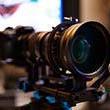
Axel
-
Posts
1,900 -
Joined
-
Last visited
Reputation Activity
-
 Axel reacted to Cinegain in Stabilizers: M�VI or BeSteady [or others]?
Axel reacted to Cinegain in Stabilizers: M�VI or BeSteady [or others]?
I put in the link earlier on for a reason. This is already happening.
So...
-
 Axel got a reaction from Henry Gentles in DIY shoulder support for BMPCC (less than 50 bucks)
Axel got a reaction from Henry Gentles in DIY shoulder support for BMPCC (less than 50 bucks)
This is my fifth attempt to find an affordable stabilization solution for the BMPCC, particularly for the heavy setup with Speedbooster and Sigma 18-35. It works perfectly, and the only two things that are missing are
1. Pistol grip to be clicked underneath the cage with a quick release plate and
2. Lanc-controller with button on top of the grip for START/STOP.
It consists of an old, self-built shoulder pad with counterweight (aluminum rack, ~$ 5,- , bent in a vice and padded with foam rubber, ~ $ 2,-), a micro goose neck with 3/8" connections, ~ $ 7,- , filled with a steel rod, ~ $1,-) and a ball head (~$ 30,-).
The ball head allows for fast height- and angle-adjustments. I found this to be the most crucial aspect of all shoulder supports. You both stress your neck with only half an inch of unergonomic proportions and run the risk of unintentionally rotating your frame. Not with this ball head.
If you loosen the ball, you can screw it on or off the cage within 10 seconds.
The counterweight could be substituted with a battery pack, and the rod that helds the goose neck stiff could also be a steel tube (well, perhaps, it could turn out to be too weak then) to hide the cable.
The shoulder pad doesn't look particularly elegant, I'm sure you can do better.
-
 Axel got a reaction from Zmu2 in DIY shoulder support for BMPCC (less than 50 bucks)
Axel got a reaction from Zmu2 in DIY shoulder support for BMPCC (less than 50 bucks)
This is my fifth attempt to find an affordable stabilization solution for the BMPCC, particularly for the heavy setup with Speedbooster and Sigma 18-35. It works perfectly, and the only two things that are missing are
1. Pistol grip to be clicked underneath the cage with a quick release plate and
2. Lanc-controller with button on top of the grip for START/STOP.
It consists of an old, self-built shoulder pad with counterweight (aluminum rack, ~$ 5,- , bent in a vice and padded with foam rubber, ~ $ 2,-), a micro goose neck with 3/8" connections, ~ $ 7,- , filled with a steel rod, ~ $1,-) and a ball head (~$ 30,-).
The ball head allows for fast height- and angle-adjustments. I found this to be the most crucial aspect of all shoulder supports. You both stress your neck with only half an inch of unergonomic proportions and run the risk of unintentionally rotating your frame. Not with this ball head.
If you loosen the ball, you can screw it on or off the cage within 10 seconds.
The counterweight could be substituted with a battery pack, and the rod that helds the goose neck stiff could also be a steel tube (well, perhaps, it could turn out to be too weak then) to hide the cable.
The shoulder pad doesn't look particularly elegant, I'm sure you can do better.
-
 Axel reacted to Kwai Bun in BMPCC - experiemnt for still photography - with C-mount lens
Axel reacted to Kwai Bun in BMPCC - experiemnt for still photography - with C-mount lens
Hi,
I'm both videographer and photographer. Recently I try to use BMPCC as a still photography tool. Ya it's experimental but it gives some nice and unique results and images. Why do this when there are 16-36Mpix cameras?
see this post in my blog:
http://kwaibun.asia/index.php/blackmagic-avant-garde-way-of-photography/
Kwai
-
 Axel got a reaction from dafreaking in Potential changes to the forum to prioritise good content, suggestions welcome...
Axel got a reaction from dafreaking in Potential changes to the forum to prioritise good content, suggestions welcome...
Let's be brutally honest. Of all the videos in the Screening Room, only, say, ten impressed me at all. My own stuff would also go unnoticed, for it isn't any better.
A contest could be a good way to focus our ambitions. Set a motto, a subject, set a date, when all films have to be online on the same day (not earlier, not later). Create a poll for ten days (or so). Allow people from outside EOSHD to vote (don't know how, perhaps via facebook?).
-
 Axel got a reaction from Julian in Potential changes to the forum to prioritise good content, suggestions welcome...
Axel got a reaction from Julian in Potential changes to the forum to prioritise good content, suggestions welcome...
Let's be brutally honest. Of all the videos in the Screening Room, only, say, ten impressed me at all. My own stuff would also go unnoticed, for it isn't any better.
A contest could be a good way to focus our ambitions. Set a motto, a subject, set a date, when all films have to be online on the same day (not earlier, not later). Create a poll for ten days (or so). Allow people from outside EOSHD to vote (don't know how, perhaps via facebook?).
-
 Axel got a reaction from nahua in Potential changes to the forum to prioritise good content, suggestions welcome...
Axel got a reaction from nahua in Potential changes to the forum to prioritise good content, suggestions welcome...
I subscribe to the 'evolution' theory above.
There are so many changes in the video market, one just can't google everything. I receive newsletters from Adobe, Avid, BMD, Apple, Panasonic, Sony, CreativeCow, NoFilmSchool, Wolfcrow and a bunch of german sites, but I learn faster and more from EOSHD.
Here is how it works: Andrew shovels in articles. People leave their comments, many in the way of dogs who set their marks on new trees. But very quickly you have a broad scope of opinions, of aspects. They aren't reliable, many aren't even on topic, but in the end, one knows more.
-
 Axel got a reaction from Sean Cunningham in Potential changes to the forum to prioritise good content, suggestions welcome...
Axel got a reaction from Sean Cunningham in Potential changes to the forum to prioritise good content, suggestions welcome...
I subscribe to the 'evolution' theory above.
There are so many changes in the video market, one just can't google everything. I receive newsletters from Adobe, Avid, BMD, Apple, Panasonic, Sony, CreativeCow, NoFilmSchool, Wolfcrow and a bunch of german sites, but I learn faster and more from EOSHD.
Here is how it works: Andrew shovels in articles. People leave their comments, many in the way of dogs who set their marks on new trees. But very quickly you have a broad scope of opinions, of aspects. They aren't reliable, many aren't even on topic, but in the end, one knows more.
-
 Axel got a reaction from Julian in Potential changes to the forum to prioritise good content, suggestions welcome...
Axel got a reaction from Julian in Potential changes to the forum to prioritise good content, suggestions welcome...
I subscribe to the 'evolution' theory above.
There are so many changes in the video market, one just can't google everything. I receive newsletters from Adobe, Avid, BMD, Apple, Panasonic, Sony, CreativeCow, NoFilmSchool, Wolfcrow and a bunch of german sites, but I learn faster and more from EOSHD.
Here is how it works: Andrew shovels in articles. People leave their comments, many in the way of dogs who set their marks on new trees. But very quickly you have a broad scope of opinions, of aspects. They aren't reliable, many aren't even on topic, but in the end, one knows more.
-
 Axel got a reaction from JazzBox in BMPCC
Axel got a reaction from JazzBox in BMPCC
I can understand that. For anyone, who is used to *shoot video* with a classic camcorder, it's terribly unpractical. The same was true, back then, for shooting with a bulky 35mm adapter or later with a DSLR. But as the bible knows, you love the prodigal son the most.
Imho it can best be compared to ancient mechanical 16mm cameras, with which people also had their trouble. To achieve good results, you had to know them by heart, to a point, where knowledge about stock sensitivity (and characteristics) in correlation with aperture and the (mostly fixed) shutter angle turned into intuition.
I don't use a light meter, and according to some comments in other places, only few still do, even in professional cinema. You can learn to judge correct exposure with the Pocket by doing a lot of tests and comparing them to what you saw during recording. Here are my rules of thumb:
1. ISO 800 offers the best possible DR for ProRes. To have a fixed ISO also facilitates things, less factors to be calculated on the fly by your CNS.
2. ETTR is also - partly - valid for ProRes. Fill the well, avoid the noise floor. It's 10-bit, so you are not simplifying skin tones by slightly overexposing, like with 8-bit codecs. Use 95% zebra then.
3. For RAW, use 100% zebra. If the image appears too bright on the display, lower the ISO (has no influence in RAW).
4. When I still had a MFT system lens that set exposure automatically when I pressed IRIS, I realized that I always was in the same ballpark manually. No wonder: The automation uses ETTR as well.
My suggestion regarding your trip to far east:
1. Make at least ten test shots every day, document them, evaluate them, you will improve your intuitive skills.
2. Buy a used GH2 or G6 (ridiculously easy cameras compared to the Pocket). They can use the same lenses. Compare, as I did, these cameras in the same situations. At first, the results with these Lumixs will be three times better. But not for long.
3. Learn when to use RAW (seldom) and when ProRes (almost always).
4. Learn how to use Speedgrade. Not just in an afternoon. Watch whole video trainings by Lynda or the like, and delve into CC.
As I wrote before: The Zacuto Pocket finder (quite affordable) makes you see every single pixel on the muddy display and helps only a little bit as far as focussing is concerned. But you need it anyway when you shoot in daylight. And it adds a comfortable stabilization point. What you also need is some kind of additional support. Mine weighs below 100g and cost 14 € (new!).
-
 Axel got a reaction from Francisco Rios in FYI: Final Cut Pro X trouble + solution
Axel got a reaction from Francisco Rios in FYI: Final Cut Pro X trouble + solution
I am trying to avoid noisy shots. If I have one, I load it to FCP 7, where I have a stable Neat.
When cows fly. Even if FCP X doesn't crash, it gets very slow with just about every plugin you install. I have accepted that. FCP X is a very mighty footage organizer - outsiders just can't fathom how advanced it actually is in that respect. It also is the fastest editing tool - render benchmarks and GPU acceleration set aside, just from the way the edits are organized. It also offers a very intuitive and easy, yet limited, color correction. Everything else, to tell the truth, is in it's infancy.
-
 Axel reacted to pooli in POOLiCAGE for BMPCC
Axel reacted to pooli in POOLiCAGE for BMPCC
Hi forum.
This is my development for BMPCC
http://www.youtube.com/watch?v=tr-6hdQPlUk
-
 Axel got a reaction from skiphunt in FYI: Final Cut Pro X trouble + solution
Axel got a reaction from skiphunt in FYI: Final Cut Pro X trouble + solution
Yes, FCP X does not like third party plugins, to put it mildly. One of the most useful, the stabilizer Log & Load, is an exception. With Neat, it depends on the Neat and FCP X version. Google for the experiences of others before you ruin a project.
-
 Axel got a reaction from Julian in Your Top 10 Most Influential Feature Films (fun/non-gear-related)
Axel got a reaction from Julian in Your Top 10 Most Influential Feature Films (fun/non-gear-related)
Thanks Maxotics and Julian. These insider tips are always the best. Same with music. Mainstream is often too predictable.
A propos POV. Don't miss Enter The Void. It's a film with very many flaws and I wouldn't call it influential (at least not for me, who a least twice a year opens his 'doors of perception' as a recreative vacation).
But that's imo what most interesting films have in common: They have something that makes them stand out for the individual, in this sense:
Art is not so much about perfection than about bold exclusivity. The meanest and lowest mainstream movies can be more perfect (technically or in the closeness of narration and narrational form) than the masterpieces. Those tend to have some very strong aspects, but also flaws. Leonardo didn't know about materials, his Mona Lisa had the 500.000 crackles the moment the paint had dried (which took months though). Same with his Last Supper: The wall sucked the colors off, it weren't the farts of admirers over 500 years (source: Donald Sassoon, Mona Lisa). The numerous fakers know better than the master. Beethoven chose improper instruments for his symphonies (Bernstein said, none of his students would have gotten away with such an orchestration). Shakespeare had so many logic flaws in his (predominantly adapted) plays that a modern script doctor would despair.
-
 Axel got a reaction from Sean Cunningham in Your Top 10 Most Influential Feature Films (fun/non-gear-related)
Axel got a reaction from Sean Cunningham in Your Top 10 Most Influential Feature Films (fun/non-gear-related)
Thanks Maxotics and Julian. These insider tips are always the best. Same with music. Mainstream is often too predictable.
A propos POV. Don't miss Enter The Void. It's a film with very many flaws and I wouldn't call it influential (at least not for me, who a least twice a year opens his 'doors of perception' as a recreative vacation).
But that's imo what most interesting films have in common: They have something that makes them stand out for the individual, in this sense:
Art is not so much about perfection than about bold exclusivity. The meanest and lowest mainstream movies can be more perfect (technically or in the closeness of narration and narrational form) than the masterpieces. Those tend to have some very strong aspects, but also flaws. Leonardo didn't know about materials, his Mona Lisa had the 500.000 crackles the moment the paint had dried (which took months though). Same with his Last Supper: The wall sucked the colors off, it weren't the farts of admirers over 500 years (source: Donald Sassoon, Mona Lisa). The numerous fakers know better than the master. Beethoven chose improper instruments for his symphonies (Bernstein said, none of his students would have gotten away with such an orchestration). Shakespeare had so many logic flaws in his (predominantly adapted) plays that a modern script doctor would despair.
-
 Axel reacted to Sean Cunningham in Grading and LUTs, etc.
Axel reacted to Sean Cunningham in Grading and LUTs, etc.
Except that most of that work isn't actually enhancing the footage, it's getting to a reasonable place to start. You can't intelligently grade your footage until you see it for what it is. That's not what you really start out with most of the time when shooting raw or if you've shot linear with a baked in LOG curve.
If I was a client and I'd shot film and I got rushes back that were different every time or, worse, I was at a lab timing my film and having to sit there and watch the colorist poke around and try this or that to get my footage to simply look as filmed and as good as I would expect from rushes with house lights I would take my film and go someplace else. But somehow this is how folks are expected to work with the digital equivalent to a film negative. It's awful.
Once you're really grading, I wholeheartedly agree, methodical, logical order. But it's easy enough to see in upload after upload that most folks aren't starting their grade from a good place before trying to get to their look. Just look at Shane Hurlbut's BMD tests. They're no better looking than Joe Six Pack bought himself a BMCC's uploads to Youtube.
I've got this fellow's entire short shot on an Epic sitting on a drive. I look at the footage as-is in After Effects it looks just as bad as it does in Redcine-X. Just awful. Unusable for my purposes. So I'm having to linearize it all to a meaningful place to work that's appropriate for display on an sRGB monitor. That extra work is eating into time that might otherwise be spent doing my actual job on this fellow's film and it's going to be the same waste when he goes to do his final grade in Chicago because the colorist is dealing with it like everyone has always had to deal with it.
At least most of these cameras seem to have decent monitoring now, even if you're going to have to work to get it back to looking like what you remember from set once it's shot. One of the most said phrases by Brian Singer on the set of Superman Returns, the first motion picture shot on the first model Sony Genesis, "it's not going to look like that, right?" We have come at least that far.
-
 Axel got a reaction from skiphunt in Grading and LUTs, etc.
Axel got a reaction from skiphunt in Grading and LUTs, etc.
This is the way to go. It's what you learn in every CC tutorial, you need to enhance the image step by step, in logic order, be it through a line of stacked corrections (FCP X), rooms and multiple secondary CCs (Color) or a node tree (Resolve). Enhancing means knowing what you want to achieve before and get there by successively 'destroying' (in the sense a sculptor takes away material, not as degrading) and /or adding and changing values.
And why not take a neutralized (optimized for exposure and color fidelity) primary CC and apply an FC stock emulation? This could add a very subtle look.
The most prestigious task is not finding a pleasing look (it may be for a music video), it is getting the style right. No haphazard experiments with flavours one has no idea from which elements they are composed.
For a feature film, the director and the production designer often start with moodboards. Those are collages of photographs, sketches and bits of fabrics that help define how the film should feel. This predetermines a lot of all the things (including costumes, sets and lighting) contributing to the look, let's rather say style, desired for the final film.
Ideally, imo, I am aware what I want before I start grading. Obviously I was wrong when I accused FC of muddying the water. But it can, if you are not aware of what it's all about.
-
 Axel reacted to Rungunshoot in Travel film on 5dmkIII raw - Dubai and Oman
Axel reacted to Rungunshoot in Travel film on 5dmkIII raw - Dubai and Oman
I've been out in Dubai for commercial work, and in my spare time I used the 5dmkIII + raw to shoot a travelogue. Tried to capture some of the lesser-known parts of Dubai and the surrounding region. Enjoy!
-
 Axel got a reaction from skiphunt in Grading and LUTs, etc.
Axel got a reaction from skiphunt in Grading and LUTs, etc.
True, be inspired by great works of art in painting. How many of them rely on high resolution?
In cinema, high resolution (comparable to 4k) existed since at least six decades. The true masterpieces can be counted with the hands (you don't need fingers).
BTW: I found a good use for LUT utility for FCP X with my pocket. I can apply a Rec709 LUT (it's in the standard version) with the adjustment layer. It's a Motion title, that can be connected, easily prolonged or trimmed and filled with all filters you want to apply to a whole sequence or single clips that you can toggle on or off in their entirety by choosing the layer and hitting "v". Also available from Alex4D. I recommend that you try this template when you experiment with Osiris. It's extremely useful (of course the name derives from Adobe).
-
 Axel reacted to skiphunt in Grading and LUTs, etc.
Axel reacted to skiphunt in Grading and LUTs, etc.
Regarding looks.... Matt's signature quote from David Lynch reminds me of an interview I read of his, or maybe heard... can't remember. The quote may actually be from the interview. But, the gist of it was an answer to a question about high definition. David Lynch was saying that he didn't much care for it at the time and felt it was waaaay too much detail. So much detail that the magic and mystery of the dreamlike illusion were being destroyed. And, that he preferred the softer constrasty look of old 16mm films where the viewer had to fill in what was in the shadows with their own imagination.
Or something like that. I think there's definitely something to that.
-
 Axel got a reaction from skiphunt in Grading and LUTs, etc.
Axel got a reaction from skiphunt in Grading and LUTs, etc.
I found out for myself: Grading luma (my first primary CC step as well) is easier for me when I have a grayscale image. Where should the midtones be?
Since I know the old Color well and played around with Resolve (guided by vanHurkman's Lynda tut), I know that it's best to follow the processing logic of primarily optimizing all values. In the first step ("Color 1") I want to see every detail. In a later step ("Color x") I decide whether I go for a pseudo HDR look or i.e. crush the blacks for effect.
Therefore I first go to the saturation tab and pull all color from the image before switching to the exposure tab.
I also tried LUT utility and Osiris. Like skiphunt, I found a mix of some LUTs with my pre-"graded" images pleasing. Not sure what to think about that. Whatever helps? My goal is to be able to find the right look all by myself. I think color is the most demanding craft, and I'd like to know what it's all about (see controversial discussion >here).
-
 Axel got a reaction from skiphunt in Grading and LUTs, etc.
Axel got a reaction from skiphunt in Grading and LUTs, etc.
Depends on the camera. Make your own tests. There is a free Motion template (to be used as an effect in FCP X) that can be used subtly (not like in this demo), and it seems to sometimes do better than just "sharpen":
-
 Axel got a reaction from KarimNassar in What is the film look? Define it
Axel got a reaction from KarimNassar in What is the film look? Define it
All engineers for the broadcast industry strife to let their cameras (lenses, post-pipelines etc.) reproduce reality as best as possible. All fictional filmmakers try to make their images look as stylized as possible. The approach is different. Reality is where you park your car.
-
 Axel reacted in Grading and LUTs, etc.
Axel reacted in Grading and LUTs, etc.
I'm pretty much a noob to grading as well, but this is my usual CC workflow (all just using native FCPX colour board etc., no LUT's or FCPX presets).
Bring up the luma waveform (I find it really important), and go to the exposure board:
Bring the highlights as close to 100 as possible without blowing anything. If there is just one small highlight that has a way bigger spike than all the rest, I sometimes ignore it and let that get blown (bring the others up to 100) Bring the lows down to "0", then I always notch it up quite a bit (between +2 and +10 probably). I then use the midtones to darken the image in the shadows. If I can get the balance right, I find that this tends to give detail in the shadows without sacrificing contrast. It also allows a little colour into the shadows, which seems to give a greater sense (illusion?) of dynamic range. I don't bother with scopes for saturation:
I drag the global slider all the way up then gradually bring it down to where the colours don't look garish. Then I finesse with the high/mid/low sliders. Very often I find desaturating the shadows, bumping the mids a little, and really pushing the highlights (creating a diagonal pattern) results in a natural but punchy look that I like. Less regularly I will push the shadows and highs, and drop the mids (creating a "V" pattern). I only use the scopes for the colour board if I'm trying to get an accurate skin tone:
I almost always leave the global slider where it is and play around with opposing the highs and lows (complimentary colours). This is the part I find least formulaic - what works is completely dependent on the specific shot. Its fun though. I also watch out for the image breaking up if I'm being very enthusiastic with the sliders. I'll then usually go back to the exposure board and push it around until I like what I see, without worrying too much about the waveform.
The above was my workflow for my D5300 slow-motion test (which I know you've already seen Skip). It's very heavily graded, and I'm actually really pleased with how it came out. Shot with the in-camera 'Neutral' profile with contrast right down:
-
 Axel reacted to maxotics in What is the film look? Define it
Axel reacted to maxotics in What is the film look? Define it
A lot of the film look has to do with 3 trucks worth of lighting, modifiers, gels, cranes and dollies. It has to do with set designers who carefully pick colors and furniture. It has to do with story-board artists who pre-visualize what will best convey the intent of the scene. It has to do with colorists, or film graders. It has to do with actors hitting their marks. It has to do with wardrobe.
I would make an argument that any camera only contributes 5% to the "film" look.







